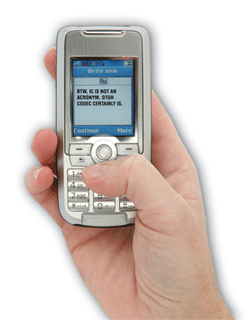Acronyms are beginning to take over everywhere. From the television commercials featuring the likes of IDK and BFF to the ICs , ADCs , and VGA you’ll see in this magazine, it would seem that Acronymia is supplanting English as the official language. Subtitles and parenthetical clues help, so you know “I don’t know” and “(variable gain amplifier),” but the use of acronyms is starting to get over the top. It can be hard to decide whether an acronym will help or hinder communication.
Acronyms are part of a kind of initiation rite into a group. That said, I don’t want to confuse readers, and I don’t want the writing in this magazine to appear to be code, something like in the want ads: “2 rms riv vu.” When I started copyediting this magazine, my coworkers said there was no need to ever write out IC , for example. Everyone knows it means “integrated circuit.” Now a colleague tells me the first thing he thinks about when he sees that acronym is the school he went to: “Immaculate Conception.”
So what’s really behind the use of acronyms? Brevity, for sure. Text-messaging depends on it because typing on a cell phone is a pain. Repetition is another. Everyone in the electronics field knows IC and ADC . VGA is tougherit’s a kind of amplifier and a kind of video adapter, depending on the context. In this latter case, writing out what you’re talking about the first time and put the acronym in parentheses would be a good way to avoid confusion.
Other times you want to write out what you are talking about and then casually drop the acronym into the conversation. You might want to do that with, say, chip-scale package. Then in a following sentence, say “The CSP . . .”

Some acronyms are so famous that no one even realizes they are acronyms. In popular culture, sonar, radar, and laser fit into this category. What do they mean? Sonar, radar, laser. Yes, yes, I know: An etymologist would tell you what the letters stand for, but some acronyms are just self-explanatory, synonyms for what they originally stood for. People have the attitude toward them that Dr. Hawkeye Pierce had on an episode of M*A*S*H . Asked by reporters what EKG stood for, he said impatiently, “I spell it E-K-G!” He was too busy saving a life to explain electrocardiograms.
Our field has such terms, too. Laser, of course, and codec and the aforementioned IC in addition to ASIC , I/O , DAC , PWM , MTTF , MTBF , and on and on. Most of these acronyms don’t spell anything pronounceable, so you just pronounce the letters: em-tee-bee-eff , for example. People can go kind of crazy with this, and others complain of TLAs (three-letter acronyms) replacing simple communication.
Acronyms can even replace language. Any amateur radio operator, or ham, knows how to communicate with a QSL card, where he or she writes down the results of a Morse code contact with another ham around the world, with searing questions like QSO (can you communicate with?) and PSC (please QSL, which in itself means “Can you acknowledge receipt?”), and ending with 73s (regards).
Acronyms and shortcuts will always be with usjust the delivery method changes.
73s, CYA — whichever you prefer.
Len Schiefer
lschiefer@hearst.com
Advertisement
Learn more about Electronic Products Magazine





